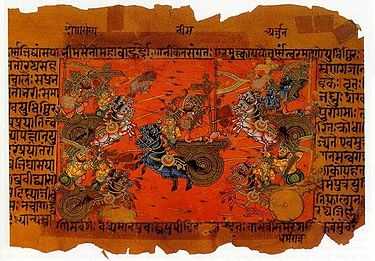Ghatotkacha

Ghatotkacha (Sanskrit: घटोत्कच Ghaṭōtkaca "Bald Pot"), is a character in the Mahabharata, which is one of the two major Sanskrit epics of ancient India, the other being the Ramayana.[1]
Ghatotkacha is the son of Bhima and the giantess Hidimbi (sister of Hidimba). His maternal parentage made him half-rakshasa and gave him many magical powers such as the ability to fly that made him an important fighter in the Kurukshetra war, the climax of the epic. He got his name from his head, which was hairless (utkaca) and shaped like a ghatam.[2]
Mahabharata

When he was young, Ghatotkacha lived with his mother, Hidimbi. One day he received a pearl which he gave to his cousin Abhimanyu.

Ghatotkacha is considered to be a loyal and humble figure. He made himself and his followers available to his father Bhima at any time. All Bhima had to do was to think of him and he would appear. Like his father, Ghatotkacha primarily fought with the mace.
His wife was Ahilawati and his son was Barbarika. Barbarika was the strongest kshatriya (rajput) according to Krishna and Meghvarna.
In the Mahābhārata, Ghatotkacha was summoned by Bhima to fight on the Pandava side in the Kurukshetra battle. Invoking his magical powers, he wrought great havoc in the Kaurava army. In particular after the death of Jayadratha, when the battle continued on past sunset, his powers were at their most effective (at night). Ghatotkach had received the ultimate boon from Krishna that nobody in all the worlds could match his magical capabilities, except Krishna himself.
At this point in the battle, the Kaurava leader Duryodhana appealed to his best fighter, Karna, to kill Ghatotkacha as the whole Kaurava army was coming close to annihilation due to his ceaseless strikes from the air. Karna possessed a divine weapon called Indrastra(Naikartana) or Shakti, granted by the god Indra. It could be used only once, and Karna had been saving it to use on his arch-enemy, the best Pandava fighter, Arjuna.
Unable to refuse Duryodhana, Karna used the Indrastra(Naikartana) against Ghatotkacha, killing him.[2] This is considered to be the turning point of the war. After his death, the Pandava counselor Krishna smiled, as he considered the war to have been won for the Pandavas now that Karna no longer had a divine weapon to use in fighting Arjuna.
There is a temple built in Manali, Himachal Pradesh for Ghatotkacha near Hidimba Devi Temple.
Death

Uncharacteristically, the battle extended into the hours of darkness. Ghatotkacha, the half-asura son of Bhima, began to destroy the Kaurava forces. It was a characteristic of the asuras that they became extraordinarily powerful at night. Their magical powers were also extremely effective. Duryodhana and Karna bravely stood and fought him. Finally, when it seemed that Ghatotkacha would destroy all the Kaurava forces that very night, Shakuni and Duryodhana called upon Karna to use all means necessary. Karna engaged him in a ferocious duel, with every single warrior from both sides watching in silent awe. As Ghatotkacha began to use his skills of dark magic, Karna had to use the Indra Shakti, which had been gifted to him by Lord Indra in return for his divine armour and earrings. Using this weapon, Karna killed the Asura Ghatotkacha. It is said that when Gatotkacha realized that he was going to be mortally wounded by the weapon,he assumed a gigantic size. When the huge body fell, it crushed one 'Akshauhini' of military which was an ancient battle formation that consisted of 21,870 chariots ; 21,870 elephants; 65,610 cavalry and 109,350 infantry.[3]
Although his death was a major disappointment to the Pandavas, there was a serene smile on Krishna's face. Krishna knew that, because Karna had now expended this fearsome weapon, Arjuna was no longer vulnerable to it.
In other literature
Ghatotkacha is the main character in Bhasa's play, Madhyamavyayoga. This play depicts a scene outside the Mahabharata in which Ghatotkacha is sent by his mother to bring back a human for her to feast on, but he is hindered by the appearance of his father, Bhima.
In the Indonesian Javanese version of the Mahabharata, Ghatotkacha's birth name was Jabang Tetuko. Indonesian version of Ghatotkacha (commonly written as Gatotkaca) also has a human form instead of a Rakshasa, wearing a vest with a sun symbol. He is famous for his nickname, "otot kawat tulang besi" (muscle made of wire and bones made of steel), and Satria Pringgandani (knight of Pringgandani).
In popular culture
- A 2008 animated film Ghatothkach was based on his life. It was directed by Singeetham Srinivas Rao.
See also
References
- ↑ Datta, Amaresh (2006-01-01). "The Encyclopaedia of Indian Literature (Volume Two) (Devraj to Jyoti)". ISBN 978-81-260-1194-0.
- ↑ 2.0 2.1 http://members.cox.net/apamnapat/entities/Ghatotkacha.html
- ↑ Amar Chitra Katha #592, ISBN 9788184821994
External links
| |||||||||||||||||||||||||

